Science fiction and fantasy (and various other genres) often feature couples whose affection for each other is unassailable, thanks to the unparalleled virtues possessed by both of the partners. However, there are also great romances that are notable because the people involved are NOT peerless paragons who are easy to love. Rather, these relationships are memorable because one partner’s deep flaws in no way inhibit the other’s sincere love.
Perhaps some examples would be appropriate. Here are five.
Melissa Khan and Cletus Grahame from Gordon R. Dickson’s Tactics of Mistake (1971)
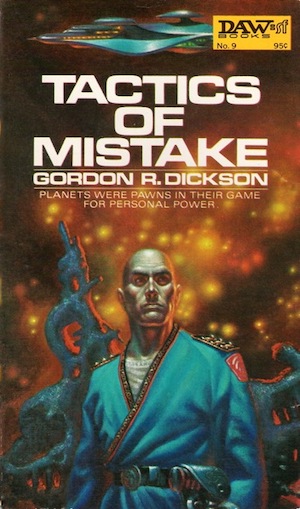
Western Alliance officer Cletus Grahame’s conviction that he has the insight to revolutionize military strategy takes him to the stars. Provided the opportunity to put his theories into practice, Cletus goes from victory to victory. Even defeats eventually are revealed as successes.
Nowhere is this truer than on the battlefield of romance. Objective observers might well describe Cletus’ courtship of Melissa as somewhere between comprehensively inept to forthrightly hostile (romance is a professional impediment, you see). Nevertheless, Melissa is convinced Cletus loves her. Thus, despite his best efforts to fend off true love, in the end Cletus gets the girl. Or more accurately, Melissa gets her soldier.
A cynic reading Tactics of Mistake might speculate that success comes less from Cletus’ unparalleled genius than the fact the author keeps one thumb firmly on the scales, ensuring Cletus’ enemies obliviously wander into every trap Cletus sets for them, no matter how obvious the gambit. Melissa’s dogged pursuit of the frankly off-putting Cletus is part of the pattern. Even when he loses, Cletus wins.
Kuroe and Arata from Spica Aoki’s Kaiju Girl Caramelise (2018 onward)
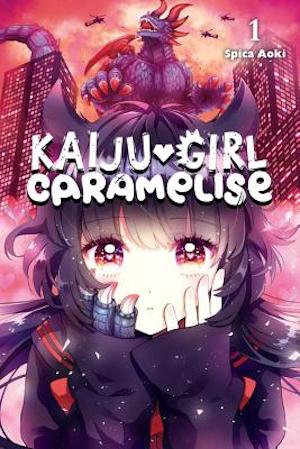
High-school idol Arata and school outcast Kuroe seem an odd romantic couple to schoolmates. Unlike his superficial chums, Arata can see the true Kuroe under her defensive reclusiveness. Arata’s canny insight enables him to perceive lovable virtues others overlook, which makes it even odder that Arata habitually overlooks the physical quirk Kuroe is desperate to conceal. Occasionally, when stressed, Kuroe transforms into the office-building size kaiju Harugon. By occasionally, I mean frequently. Adolescence is inherently stressful.
There is a long tradition of people with secret identities concealing their other identity from significant others for fear of rejection or worse. Kuroe would be one example. However, it’s very clear in this case that Arata doesn’t care about appearances. Even if he were forced to acknowledge that Kuroe and Harugon are the same person, Arata’s feeling wouldn’t change. (But try convincing Kuroe of that…)
Moon and Sparks from Joan D. Vinge’s The Snow Queen
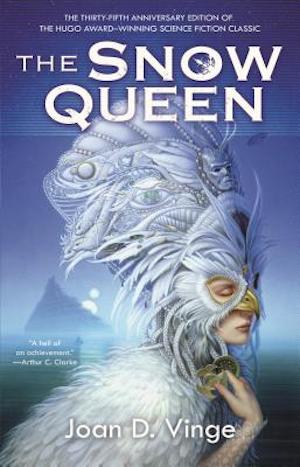
Sweethearts Moon and Sparks are separated by destiny and time. Destiny: Sparks resents the fact that Moon is a sibyl, while Sparks is not. Time: Moon becomes an unwilling relativistic traveler. Years pass before she can return to her native world—years a bitter Sparks uses to become the debauched plaything of planetary ruler Arienrhod. Can Moon’s love redeem her fallen lover?
In Spark’s defense Moon is, for reasons too complex to explain, Arienrhod’s illicit clone. It makes sense that if he found one attractive, he would fall for the other as well. However, a question more important than “can Moon’s love redeem her fallen lover?” is “is there any evidence at all that spoiled man-child Sparks is redeemable?” As presented in the novel, the answer is “no.”
The author did eventually make an author’s saving throw, replacing the comprehensively deplorable Sparks as love interest with the morose, unlucky, but relentlessly reliable BZ Gundhalinu. That had to wait for the sequel, The Summer Queen.
Anthony Rogers and Wilma Deering from Philip Francis Nowlan’s Armageddon 2419 A.D. (1928)
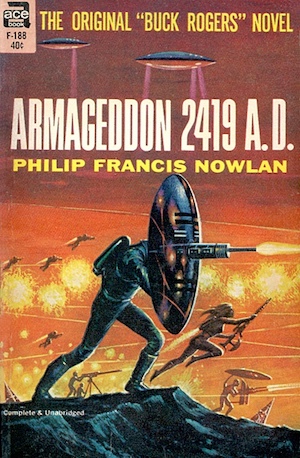
[Note: The publication date is somewhat complicated by the fact the 1960s novel published as Armageddon 2419 A.D. was a fixup of the 1928 novella Armageddon 2419 A.D. and its 1929 sequel The Airlords of Han.]
Waking after centuries to find America a nation long colonized by the Han.1 Anthony Rogers joins with Wilma Deering and her fellow Americans in their effort to liberate America from tyranny. The struggle provides Anthony with ample opportunity to notice and appreciate Wilma’s many sterling qualities. It’s no surprise that he falls in love with her.
However, his memoirs make clear that Rogers is both aware of and eager to explain away one notable quirk: Wilma’s genocidal fury towards the Han people.2 Rogers’ initial defense is to point out that Wilma is quite gracious towards people of other races aside that one specific exception. Perhaps feeling “she’s only murderously racist towards one group” is rather insufficient, Rogers then offers a defense best described as “deeply unfortunate” and “something you will regret asking about.”
It says something about the unseemly enthusiasm with which Wilma pursues her vendetta that the lead character in a Yellow Peril novel feels he has to take the time to excuse his love interest’s homicidal proclivities. It’s not terribly surprising that that aspect of the story was dropped in the Buck Rogers comic strip adaptation.3
Lord Chup and Lady Charmian from Fred Saberhagen’s Empire of the East (1978)
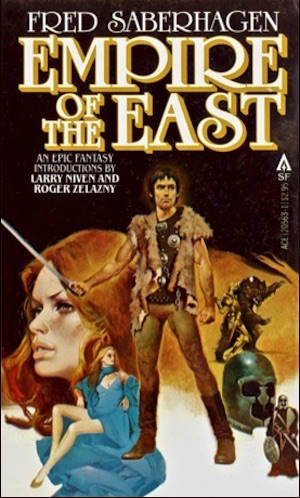
In a world dominated by the corrupt and malevolent Empire of the East4, Lord Chup stands out as one of the Empire’s few pragmatists. Eschewing sadism as beneath him, Lord Chup’s cruelties always have some useful goal in mind. It’s not terrible surprising, therefore, that he eventually rejects the Empire’s often counter-productive decadence to join the rebel alliance.
There is a singular exception to Lord Chup’s pragmatism, which is his devotion to his wife, Lady Charmian. The ambitious Lady Charmian makes frequent attempts to betray and murder Lord Chup. He is not a love-blinded fool; he is entirely aware of his wife’s true nature. He loves her anyway.5
***
There were many examples that came to mind but didn’t quite make the cut (Mary O’Meara, for one). Perhaps one of your favorites was omitted. If so, feel free to mention them in comments below.
In the words of fanfiction author Musty181, four-time Hugo finalist, prolific book reviewer, and perennial Darwin Award nominee James Davis Nicoll “looks like a default mii with glasses.” His work has appeared in Interzone, Publishers Weekly and Romantic Times as well as on his own websites, James Nicoll Reviews (where he is assisted by editor Karen Lofstrom and web person Adrienne L. Travis) and the 2021, 2022, and 2023 Aurora Award finalist Young People Read Old SFF (where he is assisted by web person Adrienne L. Travis). His Patreon can be found here.
[1]As I recall, the Han prefer to remain in their cities, only offering the descendants of Americans the occasional sweep of the disintegration ray when Americans inconvenience the Han with some provocation like a bandit raid. Mere existence is also provocative.
[2]The Han treated Americans no worse than Americans treated the North American Indigenous population, so it’s hard to see why Wilma is so upset. Surely, turnabout is fair play?
[3]It’s also best not to ask how the Buck Rogers comic strip portrayed Japanese people during World War Two.
[4]Note that “Empire of the East” is an omnibus edition of “The Broken Lands” (1968), “The Black Mountains” (1971), and “Ardneh’s World” (1973), which were edited and in one case retitled for the omnibus.
[5]Lady Charmian’s life expectancy is no doubt greatly enhanced by the fact that she’s complete crap at scheming. Lord Chup invariably sees through her plots. Were she cannier, Lord Chup’s pragmatism might compel him to make some tough decisions…











Hm. Needs more Vorkosigan…
And more Penric/Desdemona/Nykis
Boy Staunton and Leola Cruikshank in Fifth Business. What a cad Boy Staunton was, but Leola stood by him regardless.
Mark notwithstanding, I don’t think Vorkosigans are that flawed, just Barrayaran. And Penric/Desdemona and Nykis are eminently lovable.
My taste in books lately does not trend towards difficult couples so I don’t have any examples to add.
I can’t think of any couples in Bujold where one partner so wilfully ignores their partner’s manifest flaws.
A comic book example would be Harley Quinn and the Joker, at least before Harley dumped the Joker. Arguably, Harley is now the romantic load for Poison Ivy…
Grace Delarua and Dllenahkh in Karen Lord’s The Best of All Possible Worlds.
I feel like the entire category of centuries-old vampires dating high schoolers probably deserves more disapproval than it gets. Still, not as bad as the lead from Letter to a Phoenix, who is almost 200,000 years old and only marries sixteen-year-olds. I’d quote but cut and paste apparently requires tricks I lack.
noblehunter @@.-@, James Davis Nicoll @5 — Miles’s pursuit of Ekaterin is somewhat problematic, but she does get assurance from reliable sources that he is good at learning from his mistakes. Mark is badly broken, but Kareen is aware of his damage and is one of several people working to heal him. She’s not blind to his flaws, rather the opposite — some of her university classes appear to be taken towards being able to help him more effectively.
Takver and Shevek in The Dispossessed are my favorite couple, but I’m not sure they qualify, since most of the obstacles to their relationship are externally imposed. Maybe Shebat and her husband Chaeron (brother of the man she originally falls in love with) in the Kerrion Empire trilogy by Janet Morris?
Pretty much every romantic relationship in The Wheel of Time made me bang my head against adjacent solid objects, using the books themselves if nothing else was at hand.
It was hard to understand why these people were attracted to each other, even when the narrative was pushing it hard. Some relationships you could get behind. I was rooting for Perrin and Faile and I liked Nynaeve and Lan but even with them it was hard to figure out what had drawn them together and all of them kept making things hard for each other.
Dork Tower has on-again, off-again couple Matt and Kayleigh, who are almost ideally unsuited for each other. I don’t think it is even a case where Matt and Kayleigh dating spare the people who might otherwise date either of them. They’re just a terrible fit for each other. Why they date is unclear. It is almost as though an unkind fate pushes them together purely to deliver plot for more comics.
John Carter and Dejah Thoris come to mind, what with all their being captured and escaping and captured and escaping etc.
Plus, give a nod to Bob and Helen Parr.
And Reed and Sue Richards.
I enjoy James David Nicolls’ irony as much or perhaps rather more than the average internet commenter, but I must confess my ambiguity about which of these, if any, are worth reading, even for an inveterate consumer of Sax Rohmer pulp like myself.
Rachel Aaron’s Heartstrikers series features among the supporting cast Brohomir, dragon seer, and his beloved the literal embodiment of the apocalypse that destroyed his species’ home dimension. They are very devoted to each other.
Well, the Nolan is arguably important to the history of SF, Empire of the East is an interesting example of how fast epic plots used to move when individual volumes were 200 pages, tops, The Snow Queen justly earned its Hugo, and I am now regretting using Kaiju Girl here and not in Five Endearing Mangas about Unexpected Transformations.
Whoops, forgot the Dorsai. So, Dorsai is interesting to me because it is one [1] of the first examples I personally encountered in SF of an author with plans for an epic series that never came close to fruition. The three proposed historicals and three proposed contemporary novels were never published and for all I know were never written. Consequently, I don’t get too het up over more recent examples by living authors I won’t name because I don’t know how litigious they are, because I’ve been through this before.
It’s a rare book that doesn’t have some interesting quality, even if it is being so bad it inspires a better author to try their hand at getting published.
1: The other is the Villiers books.
Slippery Jim DiGriz and his wife Angelina (Harry Harrison’s Stainless Steel Rat series). He’s a (more or less) pacifist and bank robber, con man, etc., she’s a psychopathic killer reformed by intense psychotherapy. Together they fight crime, and ignore the discrepancies in their personalities most of the time.
The first couple that comes to mind is “Slippery Jim” Digriz and his mostly cured of psychopathy wife Angela, from Harry Harrison’s “Stainless Steel Rat” series. They managed to stay together in spite of their criminal proclivities.
Nadja and Laszlo from What We Do in the Shadows may be horrible self-centered monsters, but their open marriage, dysfunctional as it is, is rock solid. Which honestly may not be a good thing.
I absolutely LOVE Empire of the East, happy to see it here. Charmian is a memorable character.
@16 That would be the Anthony Villiers books by Alexei Panshin.
As for the actual subject under discussion, I would suggest the demon lord and holy savior couple from Kage Baker’s The Anvil of the World, except that the prequel in which she gave their backstory was hugely problematic.
In The Many-Colored Land, Bryan Grenfell is significantly more into Mercedes Lamballe than she is to him, which causes him to make a very bad life decision which leads to him unintentionally helping to topple a civilization.
20: Sorry, I used two unrelated methods to sleep badly last night. Go me.
Ted and Cynthia Randall, The Unpleasant Profession of Jonathan Hoag.
@23 I don’t think the Randalls are “surprisingly” devoted to each other.
@21 In the same series, you also have Marc and Elizabeth. She’s a healer, he’s the greatest mass murderer in history…
@0: a mere thumb on the scales? ISTM Dickson tended to climb onto the scales and bounce on them to make them move more quickly. My thumbnail of a Dickson hero is someone so Right that if he makes a chance remark about seeing sunrise over some feature in the west, the sun will immediately stop in its tracks and reverse course.
Florian 1 of C.J. Cherryh’s Cyteen is completely and fatally devoted to Catlin 1 (and both of them of course to their mistress, Ari 1) but everyone there except Ari 1 has a comprehensive case of brainwashing.
Delenn and Sheridan.
In Steven Brust’s Vlad Taltos books, Vlad and Cawti, a romance that begins when Cawti is one of the two assassins sent to kill Vlad.
She fails, is killed, then revived, then Vlad and Cawti fall in love and eventually marry.
(The relationship for various reasons goes south in the later books.)
Do Kali and Yama in Lord of Light qualify? She’s ?psychopathic?, he’s a geek who is still in love even after episodes (and Sam’s ~counseling).
“Siri” by Dan Simmons. It’s a short story but still a very sad/happy romance.
In David Weber’s early Moon Of Mutiny, The evil dictator Anu is tenaciously loved by this 2nsd in command, who runs the bio-enhancement division. (I can’t recall her name). She knows that he is a clinical paranoid psychopath, but will not allow anyone to harm him anyway.
Inn Elizabeth Moon’s Vatta’s War series, Rafe and the main character (I am blanking on her name, the one who winds up an Admiral) wind up firmly in love, although far from blind to each other’s faults.
@@@@@ 10. Dave:
The characters in The Wheel of Time have the depth and the complexity of a cardboard cutout. Their actions are simply dictated by the needs of an overconvolute, creaking plot machinery.
It seems to be an unpopular opinion around here, but that was one of the (many) reasons I stopped reading after the first book.
Another vote for Slippery Jim and Angelina here. I’d also like to offer Simon R. Green’s Hawk and Fisher, the only honest cops in the city of Haven, along with Tad Williams’s Simon and Miriamele from his books set in Osten Ard, and R. A. MacAvoy’s Martha and Mayland from Tea With The Black Dragon and Twisting The Rope.
I don’t recall Colonel Deering being particularly genocidal in the 1980’s TV series either. I’m sure if I watched it again I’d spot problematic elements relative to current cultural mores, but it’s definitely better than the original novella.
These five and every book suggested in the thread pale in comparison to the lovers in House of Suns, by Alastair Reynolds. In a light speed universe crossing to the Andromeda Galaxy only to find that the pursuit must continue. C.J. Cherryh’s The Faded Sun:Kutath might be a close second.
I remember a Twilight Zone episode in which a young astronaut, about to travel on a 50+ year voyage to another star system and back in suspended animation, meets and falls in love with a young woman he has to leave beyond. Unknown to her, he stays awake so that they will be the same age when he returns to her. Unknown to him, she volunteers to be put in frozen animation and thawed out right before his return. In the final scene, he turns and shuffles away from her so she won’t marry him out of pity…
Helen America and Mr. Grey-No -More, by Cordwainer Smith.
Croaker and The Lady in Cook’s Black Company